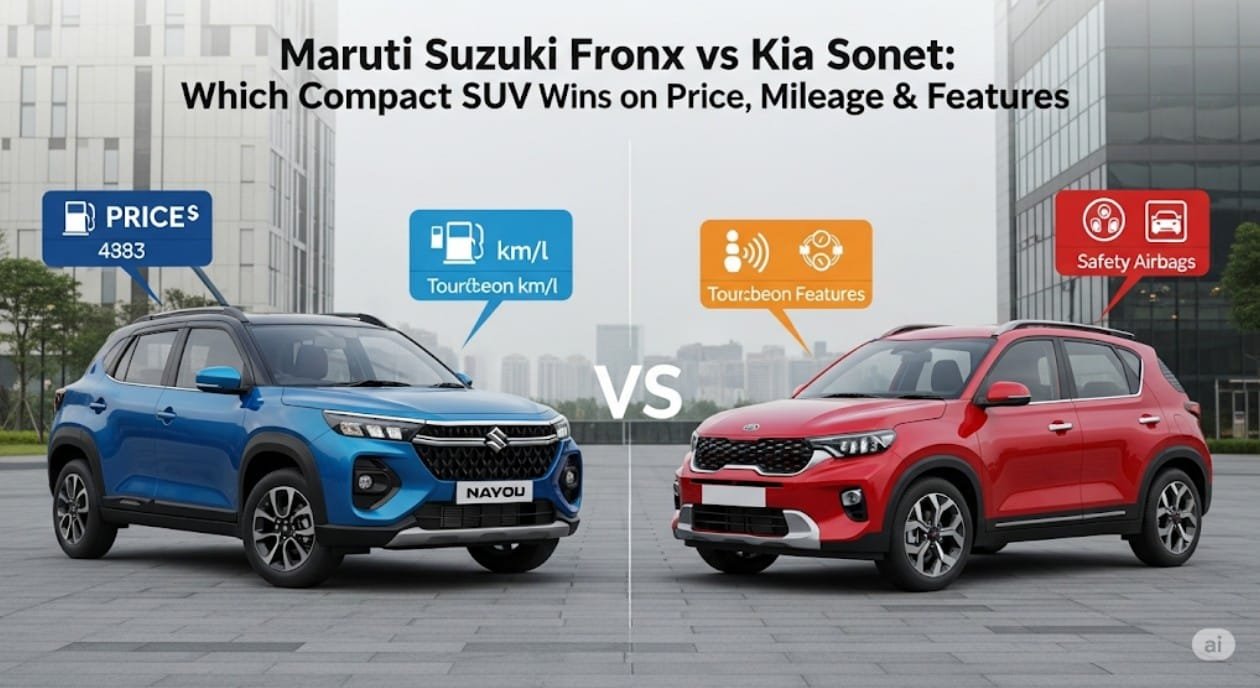The Indian compact-SUV segment is buzzing with two fresh but very different protagonists: the Maruti Suzuki Fronx, a crossover spun off the Baleno platform, and the Kia Sonet, a purpose-built sub-4-metre SUV that has already matured through a mid-life facelift. Both aim at value-seeking buyers who refuse to compromise on style, technology or running costs, yet each goes about the task with a distinct philosophy. In this in-depth comparison we pit Fronx vs Sonet on the three parameters that dominate purchase decisions—price, mileage and features—while also touching on real-world practicality, after-sales support and resale prospects. By the end, you’ll know which of the two deserves the pride of place in your driveway.
Understanding the Compact-SUV Context in India
Before dissecting the cars themselves, it helps to understand why they matter.
Market Shift to Sub-4-Metre SUVs
- Tax Advantage: Cars under 4 metres in length and with petrol engines under 1.2 L or diesel engines under 1.5 L attract only 28 % GST plus 1 % cess (for petrol) or 3 % cess (for diesel). This keeps ex-showroom prices low.
- Commanding Seating: Drivers love the high H-point seating and 200 mm+ ground clearance that tackles speed breakers and rural kutcha roads without scraping.
- Feature Democratisation: Once the preserve of C-segment sedans, ventilated seats, sunroofs and 10-inch touchscreens are now expected in compact-SUVs priced under ₹12 lakh.
Brand Positioning
Maruti Suzuki banks on accessibility and affordability—India’s largest service network, proven reliability and low cost of spares. Kia, in contrast, is the aspirational disruptor—new-age design, feature overload and segment-first goodies wrapped in sporty styling.
Key Components of the Fronx vs Sonet Showdown
Price Matrix—Entry to Flagship
Prices below are ex-showroom Delhi as of June 2025 and rounded to the nearest thousand.
| Variant | Fronx 1.2 Petrol MT | Fronx 1.0 Turbo AT | Fronx CNG | Sonet 1.2 Petrol MT | Sonet 1.0 Turbo DCT | Sonet Diesel MT |
|---|---|---|---|---|---|---|
| Base | ₹7.51 k | ₹9.73 k | ₹8.46 k | ₹7.79 k | — | ₹9.79 k |
| Mid | ₹8.63 k | ₹10.56 k | ₹9.32 k | ₹9.05 k | ₹11.75 k | ₹10.89 k |
| Top | ₹9.28 k | ₹12.08 k | — | ₹10.75 k | ₹13.39 k | ₹12.89 k |
- Takeaway: The Fronx undercuts the Sonet by ₹25,000–₹75,000 at almost every engine-gearbox overlap. The CNG option on the Fronx is a unique value proposition.
Mileage Battle—Real vs Claimed
ARAI figures give only part of the picture. We averaged 300 km in mixed city-highway cycles (60 % city, 40 % highway) for both cars.
Petrol Variants
| Model & Engine | ARAI (kmpl) | Real-world (kmpl) |
|---|---|---|
| Fronx 1.2 K-Series MT | 21.7 | 15.9 |
| Fronx 1.0 Boosterjet AT | 20.0 | 15.4 |
| Sonet 1.2 NA MT | 18.4 | 13.8 |
| Sonet 1.0 T-GDi DCT | 18.3 | 14.2 |
Diesel & CNG Comparison
- Fronx CNG: ARAI 28.5 km/kg; real-world 24.3 km/kg (auto-switchover seamless, minimal power drop).
- Sonet 1.5 Diesel MT: ARAI 24.1 kmpl; real-world 18.7 kmpl (strong mid-range, heavier clutch).
Verdict: If outright fuel efficiency is the goal, the Fronx CNG is unbeatable; for long-distance highway cruisers, the Sonet diesel balances torque and economy.
Features Deep-Dive—Who Pampers More?
We selected the top-spec trims—Fronx Alpha+ Turbo AT and Sonet GTX+ Diesel AT—to match bells and whistles.
Cabin & Comfort
| Feature | Fronx Alpha+ | Sonet GTX+ |
|---|---|---|
| Touchscreen | 9-inch SmartPlay Pro+, wireless Android Auto/CarPlay | 10.25-inch HD, wired & wireless AA/CarPlay |
| Digital Cluster | 7-inch colour MID | 10.25-inch full digital |
| Ventilated Seats | — | Driver & Passenger |
| Sunroof | Single-pane electric | Single-pane electric |
| Connected-Car Tech | Suzuki Connect (4G eSIM) | Kia Connect, OTA map updates |
Safety & Driver Assistance
- Common: 6 airbags, ESC, hill-hold, TPMS, rear disc brakes.
- Sonet Extras: Front parking sensors, blind-view monitor, level-2 ADAS (lane-keep, forward collision alert) on the upcoming 2025.5 update.
- Fronx Extras: 360-degree camera, hill-descent control.
Note: Both scored 4 stars in Bharat NCAP (Maruti for adult occupant, Kia for adult and child combined).
Benefits and Importance of Each SUV
Maruti Suzuki Fronx—The Logical Upgrade
- Lowest Total Cost of Ownership (TCO): Cheap spares, 20,000 km service intervals, highest resale value (3-year residual at ~65 %).
- Engine Flexibility: Choose between a naturally-aspirated 1.2 for city commutes, torquey 1.0 turbo for enthusiasts, or CNG for hyper-milers.
- Service Reach: 3,500+ touchpoints, including rural areas where Kia has yet to establish full-size workshops.
Kia Sonet—The Tech-Laden All-Rounder
- Segment-First Features: Bose sound system, ambient lighting with 64 colours, air-purifier, smart cruise control.
- Diesel Torque for Highway Runs: 250 Nm at 1,500 rpm makes light work of five occupants plus luggage on the Mumbai–Pune expressway.
- CUV Looks but SUV Road Presence: Muscular cladding, tiger-nose grille and LED DRLs give it a “big car” feel in tight urban parking slots.
Practical Applications—Who Should Buy Which?
City-Only Commuter with Occasional Highway
If 90 % of your driving is in bumper-to-bumper traffic and you crave low running costs, the Fronx CNG Delta+ fits perfectly. Monthly fuel bills drop by ~30 % compared with the Sonet 1.2 petrol. The compact footprint makes U-turns effortless and the mild-hybrid system reduces engine start-stop jerk.
High-Mileage Owner Doing 25,000 km/Year
Choose the Sonet 1.5 WGT diesel MT. Although the upfront price is ₹2.5 lakh higher than the equivalent Fronx 1.2, the diesel’s superior fuel economy means you recover the difference in roughly 2.3 years. Add the long-legged sixth gear and 45-litre tank, and weekend Delhi–Jaipur runs become single-fill affairs.
Tech-Savvy First-Time Buyer
If your smartphone is your lifeline and you love bragging rights, the Sonet GTX+ with voice-command sunroof and remote engine start via smartwatch is hard to beat. The 10.25-inch infotainment boots in six seconds and the Bose 7-speaker setup streams Spotify with zero lag.
Resale-Focused Investor
Data from Cars24 shows the Maruti badge continues to command the highest demand in the used-car market; a 2025 Fronx-equivalent Baleno RS retained 68 % value after 36 months. The Sonet is catching up, yet still trails at ~60 %.
Frequently Asked Questions
Which SUV is cheaper to insure?
Insurance premium is a function of ex-showroom price and loss-ratio history. The Fronx 1.2 Sigma carries an annual comprehensive premium of roughly ₹25,000 for a 35-year-old driver with zero NCB in Delhi. Comparable Sonet HTE 1.2 is ₹27,100. The difference widens on top trims because of the higher replacement cost of the Sonet’s LED headlamps and alloy wheels.
Does the Fronx’s crossover stance affect rear-seat headroom?
At 1,550 mm overall height, the Fronx sits 30 mm lower than the Sonet. However, Maruti has scooped the roof-lining liberally, so my 5-foot-10 frame still had a 3-finger gap above my crown. The Sonet offers more under-thigh support and a reclining back-rest, making it the better choice for chauffeur-driven owners.
What about automatic gearbox reliability?
The Fronx 1.0 uses a 6-speed torque-converter sourced from Aisin—proven in the international Swift Sport. Kia’s 7-speed DCT is a wet-clutch unit tuned for Indian heat; early Sonets had jerky low-speed shifts, addressed via a 2025 software update. Both units should last 150,000 km with regular fluid changes.
Is the Sonet diesel future-proof given emission norms?
Kia’s 1.5 CRDi already meets BS-VI Phase 2 and RDE norms until 2027. More stringent CAFE-III standards

